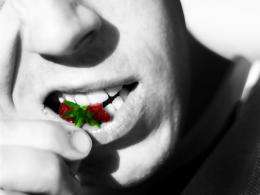Electrified dental implants

Infections on dental implants are dreaded. There is a great risk that the jawbone will recede as a result. Researchers have now developed a method that could effectively eliminate the bacteria causing the inflammation.
One shudders at the thought of passing an electric current into a patient through the titanium screw of a dental implant. Torture? No – the correct dose of electricity can kill bacteria. A few milliamperes are sufficient, which the patient perceives either as a slight muscle contraction or not at all, depending on their sensitivity and the intensity of the current. This was shown by the experiments carried out by Dirk Mohn in the context of his doctoral thesis with ETH Zurich Professor Wendelin Stark at the Institute for Chemical and Bioengineering, in collaboration with Thomas Imfeld, Professor at the Centre for Dental Medicine of the University of Zurich.
Bone atrophy and implant loss
The number of dental implants inserted in Europe and the USA has doubled in the past ten years. “It is estimated that five million dental implants were inserted in 2009 in the industrialised countries, about one million of them in Germany and 100,000 in Switzerland”, says Thomas Imfeld. He also states that, in parallel with this, the number of dental surgeons who insert implants has also doubled since 1994. The dental practitioner stresses that, according to a survey, 80 percent of Swiss dentists would perform such operations today, but only 30 percent of them would do so regularly, i.e. inserting more than 50 implants per year. Problems occur with about ten percent of the implants, mostly in the first year after the operation. Either the implant does not heal into the bone at all, or the surrounding tissue can become infected. An infection can ultimately lead to bone atrophy and thus end in implant removal by explantation.
Nowadays, so-called peri-implantal inflammation is treated mechanically using an abrasive or laser procedure, or with locally applied antibiotics. The researchers’ aim was to develop a non-invasive method to treat such inflammation effectively and gently. “The idea originates from water purification, where an electric current is used for classical electrolysis”, says Dirk Mohn. The scientists use a gelatine prepared with physiological salt solution to simulate the jaw. Into this they put original titanium implants, which they have coated prior with a film of Escherichia coli bacteria.
Success with less than 10 milliamperes
In the experimental set-up, one implant acts as the cathode and one as the anode for the flow of current. The implants are exposed for 15 minutes to a current between 0 and 10 milliamperes. The electrolysis caused by the voltage field generated led to water molecules being dissociated into hydroxyl ions at the cathode, thus raising the pH. Indicators in the gelatine show the alkaline medium by means of a colour change. Consequently, the pH decreases at the anode, and powerful oxidisers such as chlorine are formed from the salt solution. Oxidising chlorine species are the key components in the electrochemical reaction, since these substances have a much greater disinfecting capacity than the mere alkaline medium at the cathode. The series of experiments with various current intensities shows that, after a fifteen minute treatment with current of less than ten milliamperes, 99 percent of the bacteria are killed at the implants acting as anodes.
In patients, the implant would act as the anode. Mohn says that a lip clip would be a possible cathode. The scientists are currently developing an appropriate device for initial experiments on a living organism – on dogs, for example. In parallel with this, the researchers are expanding their in vitro experimental set-up with a broader population of bacteria, corresponding to the diversity of bacteria found in the mouth.
More information: Mohn D, et al. (2011): Electrochemical Disinfection of Dental Implants – a Proof of Concept. PLoS ONE 6(1): e16157. doi:10.1371/journal.pone.0016157
















